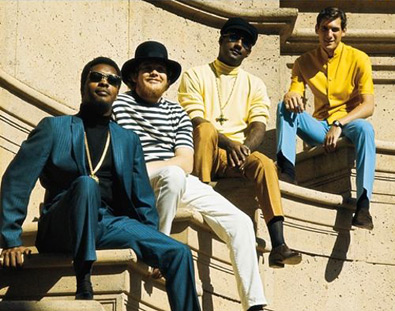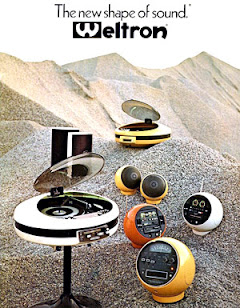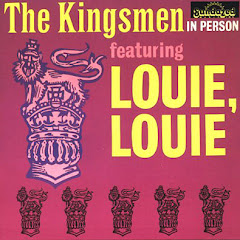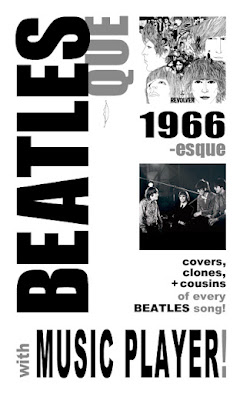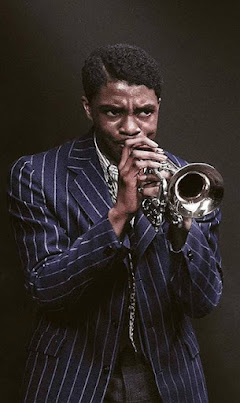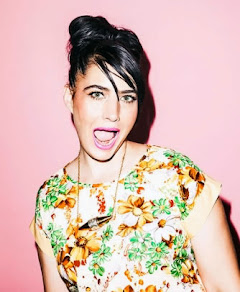...with World-Spanning Music Player!
(Part 2 of 2)
_____
Ronnie's spectre:
Amy Winehouse.
RockSex
now brings you the actual, all-inclusive history of Rock'n'Soul music, with Music Players.
▶ Music Player Checklist
Spotify playlist title=
GIRL GROUPS: Disciples 1962-TodayThis is a Spotify player. Join up for free here.
*(This Player is limited to the first 200 songs.
Hear the unlimited Playlist here.)
This Music Player covers the many songs directly influenced by the '60s GIRL GROUP sounds, across all music styles from 1962 to today, in chronological order.
Beat! Garage! Psychedelic!
Rock! Soul! Songwriter!
Punk! Funk! New Wave!
TripHop! Indie! World!
Part 1 (of 2):
YOU DON'T OWN ME: The Uprising of the 1960s GIRL GROUPS
___________________
Will You Still Love Me Tomorrow?:
The legacy of the Girl Groups
"To live my life the way I want/
To say and do whatever I please."
From the beginning, it was the harmony and the rhythm.
During the first
Rock'n'Roll years, Doo Wop led the congregation in the harmonies department. This was an outgrowth of gospel elder groups like The Dixie Hummingbirds and The Blind Boys Of Alabama, their dulcet rounds now sung by secular teens to woo dates. But just as essential were classical chorals, celtic folk ballads, romantic serenades, swing orchestra hits, torch songs, and scat-jazz mavericks for extending that palette.
Doo Wop isn't male, and there were plenty of does singing do-re-mi, too. Women sang with sisters (Shirley Gunter And The Queens, The Chordettes), with brothers (The Platters, Los Cinco Latinos), and around the world (Hermanas Navarro). At the time it was all thought of as vocal music (and Rock'n'Roll) made by and for everyone; the problem with retroactive genre terms like Doo Wop and Girl Group is that they are meant to distinguish music patterns, but only segregate the players by gender absolutes and miss the true interconnectivity of human culture. But it's all just humans making harmony with rhythm.
Diana Ross,
in designs by André Courrèges (1966).
Groups of girls like
The Shirelles,
The Chiffons, and
The Blossoms swelled over into the early '60s while the original Rock'n'Roll treaded growing pains.
> Their harmonic unity, now shifting from doo wop constraints into pure upbeat pop, stood out. These tight, punchy pop songs, with their youthful zest and bold choruses radiant through transistor radios, were more compressed and modern, with a sass and punch that the recent past had only predicted. This sound had its head in the sun with its feet square on the rhythm. At the same time, designers like Mary Quant and André Courrèges were revolutionizing fashion for the modern girl, with a Mod aesthetic now streamlined, bold, and free to move. A new generation of girls came into the future feeling regenerated. It was the Jet Age and this was their coming out music.
But music is the language of every heart and boys loved it, too. Girl Group sounds permeated every airwave, jukebox, dance, and ear, and moved everyone. What gets forgotten is that this vocal pop was just considered Rock'n'Roll and was reflected back accordingly, from the British Invasion onward. From the early '60s to today, in every variant of Rock around the world, those sounds have never stopped resounding.
This
Music Player details how those specific Girl Group sounds -big productions, soulful dance, and choral harmonies- reverberate through all kinds of music directly to this day, in many surprising ways that challenge and expand the general narrative.
The Beatles with Mary Wells.
This sound had a bracing effect on
The Beatles, who were as intoxicated with this new music as the older rockabilly of their heroes. They covered three of them on their debut 1963 album alone:
The Cookies'
"Chains", and
The Shirelles'
"Boys" and
"Baby It's You". Soon they followed with
The Marvelettes'
"Please Mister Postman",
The Donays'
"Devil In His Heart",
Peggy Lee's
"Till There Was You" (via the 'The Music Man'), and the live BBC take on
Little Eva's "Keep Your Hands Off My Baby".
They insisted on meeting The Supremes, who responded in kind with their own
A Bit of Liverpool covers album. They wrote hit songs for compatriots like Cilla Black and Mary Hopkin, and asked Jackie DeShannon and The Ronettes to tour with them. The Shangri-Las'
"Remember (Walking In the Sand)" may have had a profound effect on John; its heavy descending chords and echoed wash of harmonies bear a certain kinship to his later
"I Want You (She's So Heavy)". Also, George signed Doris Troy ("Just One Look") and Ronnie Spector to Apple Records. This kind of affection came back to haunt him when he unconciously based
"My Sweet Lord" on
"He's So Fine" by The Chiffons, which became a legal migraine. When John and Paul broke as partners, they each went forward singing with their life partners, Yoko and Linda.
The Ronettes
with Phil Spector and George Harrison.
The British Invasion reflected America back to itself, often with loving covers that they hadn't heard in the first place.
The Moody Blues broke through with Bessie Bank's
"Go Now",
The Hollies with Evie Sand's
"I Can't Let Go",
The Searchers with DeShannon's
"Needles and Pins" and
"When You Walk In the Room", and
The Animals immortalized Nina Simone's
"Don't Let Me Be Misunderstood".
The Yardbirds brought the fuzzy snarl to The Shirelles'
"Putty In Your Hand".
Manfred Mann chanted The Exciters'
"Do-Wah-Diddy". Lesser known bands did great glosses as well, such as
The Action's
"I'll Keep On Holding On" (The Marvelettes).
Every singer loved a good song. So this went both ways, of course, with Dionne Warwick and Sandie Shaw covering
"There's Always Something There To Remind Me" (Lou Johnson), The Shangri-Las sighing
"He Cried" (
Jay And The Americans), and Aretha Franklin swinging
"Eleanor Rigby". Culture is conversation, not monologues or doctrine.
Globally, the Girl Group sounds immediately reverbed revamped by cover versions in the native tongues of
Los Pekenikes (Spain),
Sylvie Vartan and
Ray Anthony (France),
Helena Vondrackova (Czech),
Equipe 84 (Italy),
Las Mosquitas (Mexico),
Les Bises (Canada), and patois of
Laurel Aitken (Jamaica).
Girl Group, particularly in Phil Spector productions, had a grandiose sound and declarative heart; these full orchestras and fuller lungs breathed new bredth into Rock'n'Roll beyond tuff licks and swivel hips. And the vocal group sound became far more fluid with
Brian Wilson's productions of The Beach Boys and The Honeys, whose love of The Ronettes' "Be My Baby" led to Spector-esque songs like "Don't Worry, Baby", "Help Me, Rhonda",
"Then I Kissed Her" (The Crystals),
"Darlin'", and
Glen Campbell's
"Guess I'm Dumb". And, by extension, albums like The Beach Boys'
Pet Sounds and The Beatles'
Sgt. Pepper turned that string-pop into progressive Rock.
Brian Wilson; Janis Joplin; Isaac Hayes.
The latter '60s retained the GG refrain within new contexts and outlooks, such as
Janis Joplin offering up
"Piece Of My Heart" (Erma Franklin),
Vanilla Fudge expanding the hell out of
"You Keep Me Hanging On" (The Supremes), and
Isaac Hayes striding Dionne's
"Walk On By" into a twelve minute orchestradelic opus.
By this point, the counterculture musical
HAIR (1968) parodied the conventions of the girl groups genre:
"Frank Mills" is a biker whose friend "resembles George Harrison of The Beatles" who rips off an adoring debutante; and
"Black Boys/ White Boys" mocks the 'color line' with chocolate and peach soul sisters appraising each other's delectability. (Girl Group would get additional ribbing and respect in later musical productions like GREASE and HAIRSPRAY, and inspire fictional takes on The Supremes like DREAMGIRLS and SPARKLE.)
Aretha Franklin; HAIR original soundtrack; Carole King.
One Girl Group vet changed the music industry in the '70s with one album.
Carole King, architect of so many GG classics like
"Will You Still Love Me Tomorrow?", redefined herself as a singer-songwriter with her 1971
Tapestry album. Concurrent with the rise of early '70s feminism, it became one of the best-selling albums of all time. If Dylan had wanted to kill the Brill Building, he really just liberated them to become him. King's success as a troubadour solidified the industry clout of songwriter cohorts from Joni Mitchell to Patti Smith, Bette Midler to Helen Reddy, Carly Simon to Norah Jones, Tori Amos to Alicia Keyes. Meanwhile, her perverse inverse
Laura Nyro was pushing the envelope into origami with her acrobatic chorales, alone and with
Labelle, loosing kindred dissenters like Annette Peacock,
Diamanda Galas, and
Bjork.
Most hard-rocking 1970s jams were built on blues grooves with soul vocals. Many times they recovered GG-era songs they loved in this style.
Smith amped up
"Baby, It's You".
Linda Ronstadt punched through with
"You're No Good" (Betty Everett} and
"Just One Look" (Doris Troy}. Bob Seger slipped the flip on "Come To Papa" (Koko Taylor's' "Come To Mama").
The Doobie Brothers turned soul sister covering
"Take Me In Your Arms (Rock Me A Little While)" by Motown's Kim Weston.
New York Dolls.
The biker chick and epic heartbreak persona of The Shangri-Las had mammoth impact still in the Glam era. The
New York Dolls actually wanted to
be them in a carnal tryst with The Stones, and their wardrobe and setlist proved it. They swiped the line "When I say I'm in love, you best believe I'm in luv, L-U-V!" for their
"Looking For A Kiss", even enlisting George "Shadow" Morton to produce their first album.
Aerosmith furthered this adulation with their remarkably faithful cover of
"Remember (Walking In the Sand)", while also subtly recalling
"I Want You (She's So Heavy)".
The Runaways rocked as hard as anyone, while -like
Queen and
Heart- still retaining excellent and accomplished harmonies; their Juvie jailbreak saga in
"Dead End Justice" rings with Shangri-Las drama.
Joan Jett, Debbie Harry, David Johansen, Joey Ramone.
The first Punk single in England,
The Damned's 1976
"New Rose", nicks its opening line "Is she really going out with him?" from The Shangri-Las' "Leader of the Pack", while
Joe Jackson had his first hit expanding that same phrase into a new song.
Blondie's debut album is steeped in beat rhythms and girl group harmonies. Their first single,
"X-Offender", updates dream romance songs to the sordid realities of '76 Times Square, tongue firmly in cheek. They even covered
"Out In the Streets" so well many think it's their song.
The Ramones remembered Rock'n'Roll radio with
"Baby, I Love You" (The Ronettes) and
"Needles and Pins" (Jackie DeShannon).
Nikki And The Corvettes, their sonic sisters, were full of biker chick sass in a whole new level of risque.
Punk and feminism likewise played games with the archetypes of Girl Group songs. Joan Jett gave it her all earnestly reciting the identity manifesto "You Don't Own Me" (Lesley Gore). But others mocked all the stock sentiments of teenage rapture and naive love as outdated, such as D-Day's "Too Young To Date" ('79), Suburban Lawns' "Gidget Goes To Hell" ('79),
Hollie And The Italians'
"Tell That Girl To Shut Up" ('81), and
Josie Cotton's infamous send-up of stoic bikers,
"Johnny, Are You Queer?" ('82).
The B-52's:
Fred Schneider, Ricky Wilson (kneeling), Keith Strickland, Kate Pierson, Cindy Wilson.
A bouffant hairdo was a called a 'B-52' in the southern US, which was probably as bulletproof as the plane from hairspray. The influence of mid-'60s pop, beat, soul, and girl party records on the Athens band
The B-52's was astronomical. Their 'dance-or-dance-more' ethos was a deliberate tonic to the descending negativity that punk and postpunk were slipping into. Be fun, and unashamed! The glowing spirit of the girl group era strobes through
"52 Girls",
"Give Me Back My Man",
"Love Shack", and their soused cover of
"Downtown" (Petula Clark).
As the '80s re-embraced Motown, the jaunty beat of
"You Can't Hurry Love" paraded through new songs by
Iggy Pop,
Elvis Costello,
The Jam,
Katrina And The Waves, and
The Smiths. Motortown revved the circuits in
Soft Cell's synthpop medley of
"Tainted Love" (Gloria Jones) and
"Where Did Our Love Go?" (The Supremes). In the same spirit,
Naked Eyes covered Bacharach's
"Always Something There To Remind Me".
Siblings are doing it for themselves:
Aretha Franklin, Annie Lennox, Dave Stewart.
UK soul artists crested anew throughout the New Wave years.
Annie Lennox had broke through covering
"I Only Want To Be With You" (Dusty Springfield) with The Tourists, and her
Eurythmics work shimmered with shades of Dusty, Aretha, and Francoise. ABC, Culture Club, Sade, Simply Red, Bananarama, Paul Young, Alison Moyet of Yazoo/YAZ, and Andy Bell of Erasure, are among myriad next generation UK artists who were deeply rooted in the soulful pop of the '60s. Under the '80s synth sheen beat the heart of Motown and Memphis. This rolling tide continues on lately with
Amy Winehouse,
Adele,
Duffy,
Dionne Bromfield, and Alice Russell.
Phil Spector produced the Ramones'
End Of The Century (1980), while his style haunts
The Clash's
"The Card Cheat" and
Jesus And Mary Chain's
"Just Like Honey". And would Frankie Goes to Hollywood, Art Of Noise, Public Enemy, and My Bloody Valentine ever have been as epic and densely-layered without the sonic example he set in motion with GG music?
The Girl Groups inspired The Beatles who inspired groups of girls. There were many female bands pounding out Beat music with gossamer harmonies in the '60s. In the mid '80s, a new wave of the Girls In The Garage cycled back with engines revving in
The Visible Targets,
The Go-Go's,
The Bangles,
The Pandoras,
The Delmonas, and
Les Calamites.
Besides Motown jaunt and Beat sunshine, Girl Group also encompassed angel girls with luminous harmonies in dense moodscapes. Elizabeth Fraser and
Cocteau Twins now blendered this into a mesmerizing maelstrom of darkness and light, hinging toward Shoegaze and TripHop to follow.
Julee Cruise; esiurC eeluJ.
David Lynch lives in dreams, where events blur, meanings change, and mystery is life's breath. He revels in ethereal light and supple darkness. He also seems haunted by purity that has become a memory. The effect that girl group songs in the vein of
"I Love How You Love Me" and
"Dressed In Black", coupled with the spectral highs of The Everly Brothers and Roy Orbison, had on him seeded BLUE VELVET (1986) and flourished entirely in
TWIN PEAKS (1990), thanks to the soundtracks of Angelo Badalamenti. With
Julee Cruise he had his 'dreamscape girl', even literally spotlighting her as both a siren songbird and a biker chick on the town bar's stage. She is both a memory and a prophecy, intangible but palpable.
Portishead; Garbage; The 5.6.7.8's.
'60s drama divas like The Shangri-Las, Jackie Trent, and Shirley Bassey had shone lucent within thunderstorm orchestras. Big cinematic production with eerie female vocals returned in the mid-'90s with TripHop, a hybrid of John Barry scores, hiphop beats, and Cocteau ambience, with artists like
Portishead,
Garbage,
Bjork,
Mono,
Hooverphonic, and
Goldfrapp.
Spector production, dynamic confession, and dreamy chorales bewitched all people across all borders in the '60s, and -as borne out on this Music Player- continued to do so across every decade and style. It is just as vibrant today in the music that matters.
Radically eclectic artists share this influence in common, and have been happy to reflect it. You can clearly hear it in the selected tunes here: in the Garage of
The White Stripes,
The Raveonettes,
The Gore Gore Girls,
Hunx And His Punx,
The Love Me Nots, and
Bleached; in the Indie Pop of
Cults,
Girls,
Sleigh Bells,
Panda Bear,
Dum Dum Girls,
La Luz,
Best Coast, and
Diane Coffee; in the harmonies of
Lady,
Stooche,
The Girls At Dawn,
Janelle Monae,
The She's, and
Baby Shakes; and in the variant soul of
Shelby Lynne,
Amy Winehouse,
Valerie June,
Kelis, and
Father John Misty.
The Raveonettes; The Love Me Nots; Latasha Lee.
_____
Girl Groups aren't the history of the Women In Rock, they are more specifically a valuable facet within that vast prism.
Women have been a part of every permutation of Rock from the beginning, as eclectic and vital to its progressions as their brothers. (If any source tells you differently, they are lying or ignorant.)
Girl Group was a loose term generally appraising the female vocal pop of the early '60s and its highly dynamic production values. At its best it was meant as an appreciative term of respect. At its worst it is a genderist pigeonhole that reduces all female musicians to eyecandy making soft Pop apart from Rock. Depends on the clear insight or clouded projection of the viewer.
So Girl Group isn't Barbies miming dance tracks. Girl Group isn't pretty-twenties with a sell-by date. In the real world outside that sexist cartoon, women have been a thriving part of every movement of music, a sonic inspiration for everyone, and an exponential wave that can't be contained. All the myopic critics, robot radio, daft downloaders, and J-Pop factories in the world can't dam that ocean.
(A separate series of posts will cover the larger history of WOMEN OF ROCK, decade by decade, in every style from the '20s to today.)
This essay and Music Player instead focuses on the specific influence of the actual, original Girl Group sound on all who followed. It makes it clear that the success of the 'girls grouped' unleashed the floodgates of singer/songwriters, punk poets, soul sisters, and riot grrrls that followed, with its clear sonic influence still audibly inherent within. From the refurbished vocal combos like
The Emotions,
The Pointer Sisters,
Labelle, and
En Vogue; to funk fatales like
Parlet and
Brides Of Funkenstein,
Tom Tom Club,
Mary Jane Girls, and
Peaches; (and, admittedly, to Mtv dance divas like Debbie Gibson, Tiffany, The Spice Girls, Britney Spears, TLC, and Destiny's Child that inherit the generic term Girl Group); to full-on garage grrrls like
Fanny,
NQB (Sweden),
The Pandoras, Bikini Kill,
The 5.6.7.8.'s,
April March,
The Husbands, and
Bleached.
This is dedicated "To Her, With Love".
©
Tym Stevens
See Also:
Part 1 (of 2):
•
YOU DON'T OWN ME: The Uprising of the 1960s GIRL GROUPS
_____________________
•
THE RUNAWAYS, And Why Women Of Rock Are Essential!
•
WOMEN OF ROCK: The 1950s, with 2 Music Players!
, with Music Players!
•
WOMEN OF ROCK: The 1960s, with 2 Music Players!
_____________________
•
The Shangri-Las > The Damned > Joe Jackson
•
LADIES FIRST: "Out In the Streets" - The Shangri-Las > Blondie
•
LADIES FIRST: "Remember (Walking In The Sand)" - The Shangri-Las > The Beatles > Aerosmith > Amy Winehouse
•
The Real History of Rock and Soul!: The Music Player Checklist




